
Plague Quarantine Page Menu: 1 2 3 4 5 6 7 8 9 10 11 12 13 14 15 Next>>
Golden Age of Piracy Maritime Quarantine For Plague, Page 4
The Mediterranean Lazarettos - Establishment
The first purpose-built quarantine lazaretto was erected by the Venetians in 1423.
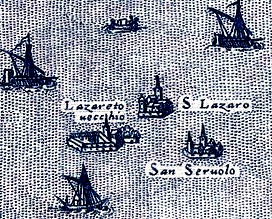
Lazaretto Vecchio on Early Map, Wellcome Collection
This was followed in 1468 by another lazaretto, with the original being called Il Lazaretto Vecchio (the Old Lazaretto) and the new one being referred to as Il Lazaretto Nuovo (the New Lazaretto). The new lazaretto served to quarantine those who were only suspected of harboring the plague while those coming from places infected or foul were placed in the old lazaretto for their quarantine. "This Venetian system, introduced primarily to guard against the introduction of plague from the Levant, gained high repute in Europe and served as a model to other countries."1 Medical historian Guenter Risse notes that "specialized institutions modeled after the Venetian hospice were also proposed for other major Italian cities such as Mantua (1450), Ferrara (1464), Florence (1463), Genoa (1467), Siena (1478), and Milan (1488)."2 Of those which Risse lists, only Genoa was used for maritime quarantine; the others were land-based, being used primarily, if not exclusively, to segregate people in the town who were either suspected or proven to have contracted the plague during local outbreaks.
Although lazarettos were seen as desirable for cities, their construction was often slow and haphazard. As frequently happens with governmental will, the desire and money to build lazarettos was present only following an epidemic. Risse suggests that "given the temporary character of both plague epidemics and health boards [created to combat them], the construction of permanent facilities was often delayed for decades in favor of makeshift arrangements that included former out-of-town monasteries and private estates."3
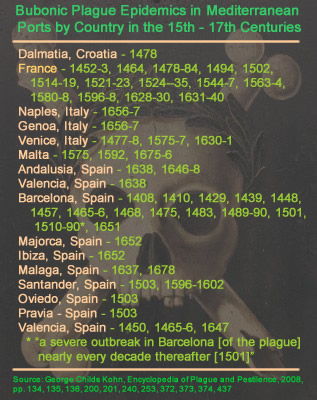
Bubonic Plague Epidemics in the Mediterranean Ports by
Country (and City where indicated) in the 15th - 17th centuries.
Background art: Pesttafel Augsburg anagoria (1607-35)
The first lazarettos often began with temporary wooden huts.4 Even when they got built, "many of the buildings stood empty, or needed repairs, their basic inventory of beds, mattresses, blankets and clothes burned"5 once the epidemic had ended.
While land-based buildings were used only as lazarettos during outbreaks of the plague, major maritime lazarettos served an ongoing purpose. Merchant ships arrived in port cities from all over and the potential for the plague occurring at one ship's previous stops created an on-going use. By way of example, a listing of some of the major plague epidemics in the Mediterranean during the fifteenth through seventeenth centuries is shown at left. Of the fifty-six instances in this chart, nineteen occurred in the fifteenth century, nineteen in the sixteenth century and sixteen in the seventeenth century.
Because they contained people who were either infected or suspected of infection, maritime lazarettos were typically placed outside of the city with which they were connected, preferably in a remote place or on an island. Risse explains that they "were established outside of towns near crossroads and in downwind locations based on similar considerations of easy access and environmental contamination. Given the prevailing winds in Europe, this meant a southeastern or eastern location at a prudent distance from human settlements."6 He adds that when placed on islands, those chosen were near port entrances and downstream if possible. Such locations also helped prevent those in quarantine from coming into contact with people in the town it was built to protect.
Something the above data reveals is that bubonic plague epidemics began to taper off in the latter half of the seventeenth century. All but two of the instances in the chart from the seventeenth century occurred before 1660. The remaining two were in the 1670's. No other plague outbreak occurred in the Mediterranean areas under study after 1678 until the 1720-1722 Great Plague of Marseille. This was actually the only major plague outbreak during the golden age of piracy. As Risse observes, "Paradoxically, just as the construction of more elaborate and permanent pest houses [lazarettos] ended, plague gradually vanished from Europe."7
1 Neville M Goodman, International Health Organizations and Their Work, Ch 2, 1971, p. 31; 2 Guenter B. Risse, Seventeenth-Century Pest Houses or Lazarettos, Jan. 1999, p. 27; 3 Risse,p. 84; 4 Risse,p. 28; 5 Risse,p. 32; 6 Risse,p. 28; 7 Risse,p. 46
The Mediterranean Lazarettos - Bills of Health
"11th October, 1644. We lay at Cannes [France], which is a small port on the Mediterranean; here we agreed with a seaman to carry us to Genoa, and, having procured a bill of health (without which there is no admission at any town in Italy), we embarked on the 12th." (John Evelyn, The Diary of John Evelyn, Edited by William Bray, 1901, p. 81)
Not all incoming ships had to perform a full quarantine at every Mediterranean port city.
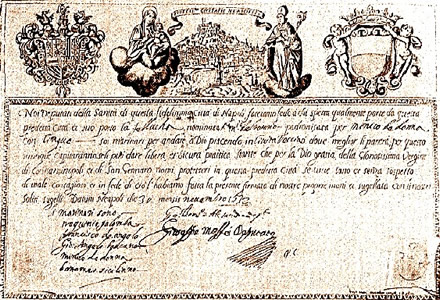
Bill of Health Issued By Naples in 1632 to the Captain of a Felluca, From Direzione
Generale
Della Sanita Pubblica, p. 32 (1910)
This would have been onerous for both the ship's crew and for the merchants who were trying to get products into the city before they spoiled or were ruined by the elements. "To avoid quarantine and obtain free pratique, ships had to produce a clean bill of health, i.e. an official document certifying that the last port of call was free from these diseases, and this bill of health in many cases had also to have the visa of the consul of the country of arrival, since this was a guarantee that the information was correct."1
Bills of health or health certificates for ships may be even more ancient than maritime quarantine. Military researcher John Macauley Eager notes that in the archives of the 'Conservatori di Mare di Genoa' [Conservatory of the Sea of Genoa] there is a "writing, dated 1300, makes mention of bulletins of health (bullettones sanitatis) with which ships from the littoral [shore region] of Corsica and Sardinia were required to be provided."2
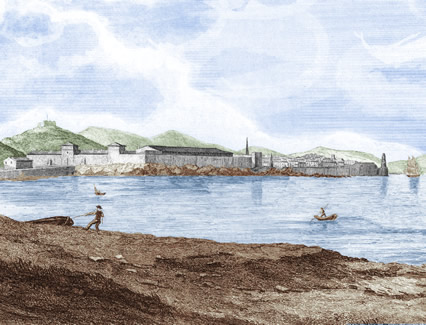
Lazaret d'Arenc, Marseille (1848)
A long period of time was to pass before these documents were next mentioned in use, however. "Bills of Health... were instituted [in Venice] in 1527; but they did not become general till 1665."3 Patrick Russel says that the Levant Company, an English chartered company formed to trade with the Ottoman empire, was using bills of health by at least 1596; "an English traveller who was at Aleppo in 1596, mentions his having a clean patent, Syria being then free from the plague."4
Once bills of health came into general use, a clean bill of health did not necessarily guarantee that a ship would completely avoid quarantine. The 1716 Marseille quarantine instructions provide an example; passengers arriving on a ship with a clean bill of health were to serve eight days in quarantine. To further complicate the process, the instructions state that passengers coming from Constantinople and the Barbary Coast had to serve two extra days for a total of ten.5 The ship itself had to serve twenty days.6
Bills of health were sometimes forged (even by English surgeons, as we shall see in the section Quarantine at Mediterranean Lazarettos - Cheating) and it was necessary for health officials to try and discern real bills from fake. With this in mind, the 1695 instructions for the health officials who served the Brazilian port of Belém and the lazaretto at Trafaria across from Lisbon gave a description of these documents:
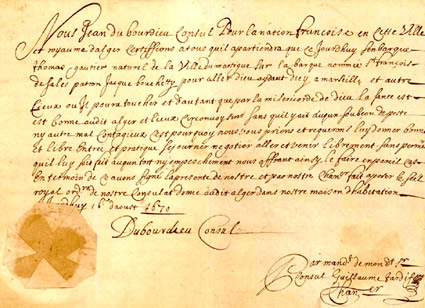
Bill of Health Issued By Algiers (1670)
Letters of health are printed or handwritten: the printed ones bear stamps, and on top are the prints of the coat of arms of the provinces or cities and are assigned by the ministers of health; they include the name of the vessel and the person who governs it, and sometimes the appearance of their face, stature and other descriptions, the number of the people in their service, and when they do not bring the number and names of passengers, each of them is obliged to bring a private passport, and these descriptions are most often used.
Some manuscripts bear stamps, others do not: the ones that bring them are passed by the health officials, and the ones that do not are passed by the residents, or sent by His Majesty, and assigned by them... in every case there is such a variety that no rule can be given to know the certainty of them, and since they are all ordered by the guard in the power of the Clerk of Health, the best way to verify them seems to be by examination, to confer with others from the same party, and, if they differ, there is just reason to suspect they are false.7
Passengers on ships which had bills of health determined to be either suspect (coming from places that might be infected but not proven so) or foul (arriving from locations known to be plague infected) had to serve longer quarantines. The Marseille instructions said that passengers coming from places with
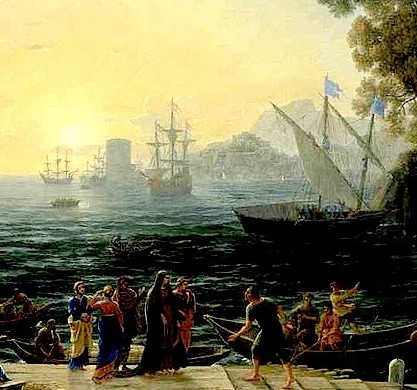
Artist: Claude Lorrain - The Sun Rising in the Levant (1650)
a suspect bill of health were to serve fifteen days of quarantine while those with a foul bill were to serve twenty.8 Passengers aboard ships where someone had died of the plague were to serve twenty days quarantine; if someone died during this period, the quarantine was extended for a period determined by the Bureau of Health in Marseilles. The ship they arrived on had to serve thirty days quarantine if the bill of health was suspect and forty if it was foul. Ships with the plague aboard had to serve even longer quarantine, with the Bureau sending them to "the Isle de Jarre for quarantine; and before unloading any Goods they must open their hatches, keeping them open for ten days to let fresh air into the ship".9 After this the normal forty day quarantine was applied. Other locations had different rules - see the section titled Quarantine at the Mediterranean Lazarettos: Goods on page 9 for more on this.
While bills of health made the system work more smoothly, they weren't always effective in preventing the plague. The only large scale outbreak of plague during the golden age of piracy began in May of 1720. The ship Grand Saint-Antoine had sailed from Cyprus after being issued a clean bill of health and cleared for France. She decided to stop at Livorno, Italy to get supplies. Five people died during the voyage from Cyprus to Livorno including the ship's surgeon, so the ship was ordered to stay out of Livorno harbor and put into quarantine. During this time three men who were ill when she arrived died. The bodies were brought ashore and diagnosed as having 'a malignant pestilential fever' rather than the plague, so the authorities of Livorno endorsed the Grand Saint-Antoine's bill of health.
A new surgeon was hired and the Grand Saint-Antoine headed for her original destination: Marseille. There, another man fell ill,

Artist: Michel Serre - Scene de la peste de 1720 a la Tourette (Marseille) (18th c.)
and the ship was treated as if it had a foul bill of health. The cargo was initially to be sent to a distant island to be fumigated with perfumed smoke in order to remove any infection, but the Marseilles Health Office changed their minds and instead sent her to the lazaretto. One of the guards watching the ship died, although it was reported to be from causes other than the plague. Ten days later by the ship's cabin boy died "and events gathered a grisly momentum. In vain did the Health Office send the ship to [the Island of] Jarre for a further fumigation. Six porters who had handled the cargo, a priest who had delivered last rites, and the surgeon of the lazaretto quickly succumbed."10 Thus began the Great Plague of Marseille, which was to kill about 100,000 people before it ended. The bill of health, certified or not, did not materially affect the outcome since the ship had been treated as infected at both Livorno and Marseille. However, the fact that she was twice issued a clean bill of health doesn't suggest much confidence in the system.
This seems to have been understood elsewhere. John Howard noted that during the 18th century, "the Venetians very justly conclude that it is precarious and highly dangerous to trust to any certificates of health what ever, whether from their own consuls or others, in places where, although the contagion do not openly appear, it may lie lurking in bales of merchandise transported from other parts."11
1 Neville M Goodman, International Health Organizations and Their Work, Ch 2, 1971, p. 31; 2 John Macauley Eager, "The early history of quarantine," Yellow Fever Institute Bulletin No. 12, March, 1903, p. 18; 3 Johannes Noel, The Black Death: A Chronicle of the Plague, C. H. Clark, Translator, 1971, p. 73; 4 Patrick Russell, A Treatise on the Plague, Vol. 2, 1791, p. 318; 5 Daniel Panzac, "Appendix 1: INSTRUCTION POUR LES INTENDANTS DE LA SANTE SUR LES USAGES & COUTUMES DU BUREAU", Quarantines et Lazarets, 1986, p. 136 - translated by the author; 6 Panzac, "Appendix 1", p. 134; 7 Eduardo Freire de Oliveira & Câmara Municipal de Lisboa, Elementos para a historia do municipio de Lisboa, Tomo X, 1899, p. 426-7; 8 Panzac, "Appendix 1", p. 136; 9 Panzac, "Appendix 1", p. 134; 10 John Booker, Maritime Quarantine: The British Experience c. 1650 -1900, 2007, p. 87; 11 John Howard, An Account of the Principal Lazarettos In Europe, 1791, Vol. 2, p. 18
The Mediterranean Lazarettos - Processing Incoming Ships
A ship arriving in a port which practiced maritime quarantine was first approached by personnel from the lazaretto who kept a respectable distance from those aboard to avoid any chance of being infected. They took the ship's documents, purified them and then brought them to the local Board of Health. The captain and others aboard the ship were interviewed, sometimes on their ship, other times on land with different people's answers being compared to verify each other.
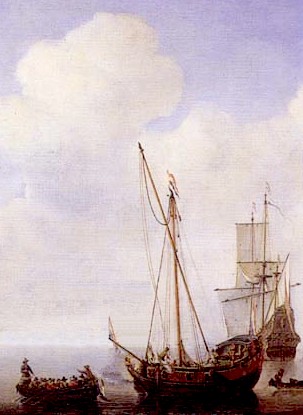
Artist: Willem van de Velde the younger
Ships Riding Quietly at Anchor (17th century)
An inspection of the ship's crew and passengers was typically performed. This information was used to determine the amount of time the vessel, passengers and goods needed to spend in quarantine.
John Howard explained, "it is an established rule, to treat all ships and merchandise on their arrival at Venice from... suspected places, with the same caution and reserve, as if they were actually infected; and to obviate all danger before their arrival"1. Howard, who purposely served the quarantine in Venice, said that on such ships "a guardian is dispatched on board, whose office and duty commences from that moment, and continues till the ship has performed quarantine"2. Howard explains that a vessel filled with soldiers is sent to the ship by the health authority, keeping their distance from it, "to observe that nothing is done against the established laws. Then one of the messengers goes to conduct the captain to the health-office; his boat keeps a proper distance before that of the captain, clears the way, and takes care that no communication is held between those in the suspected boat and others."3
In a similar way, the 1695 Instruzzioni e governo del lazzaretto di Messina also state that when a ship appears at their port, a guardian is immediately sent to the ship to interview the captain. He asks "where they come from, where they have stayed, and with whom they have traveled"4. In cases where the answers indicate a vessel came from a suspect place, the guardian questions those on the ship from a distance, asking "the Captain, Passengers, and Mariners where they came from, the ship's entire itinerary and the places where they have touched, giving detailed receipts"5.
Several documents discuss the interview process and questions which were asked of the crew. Howard gives the best account of the process, which he witnessed at Venice in the late 18th century. Note that, unlike the Messina lazaretto, those to be questioned were brought to an office on the quarantine island at Venice.

Artist: Phillipe Jacques de Loutherbourg
An Obdurate Sailor (mid 18th century)
When they arrive at the landing place of the office, which is so contrived that the captain and people may talk with those on shore without approaching too near, he is forthwith conducted into an enclosed entry for that purpose, adjoining to the office, where his report is taken by a clerk, from a window at due distance; the usual questions are asked, such as, from whence he comes ; when he left his port; whether he has a clean bill of health or not; what kind of voyage he has made; if he touched intermediate ports; if he had product [pratique] in them, or not; if he met vessels at sea; and of what nation; if he were aboard of them, or they of him; how many hands he has on board, and if any passengers; if they have been all the voyage in health, or if any be dead, or sick; what his loading consists of; if he took it in all in one port: this report is written down by the clerk, and then all his papers and letters are demanded.6
The 1661 Serenissima Republic Health Instructions (the Venetian Republic was traditionally known as the La Serenissima) includes specific instructions for what was to be asked of the captain or owner of a vessel as well as some of the sailors who arrived in Corsica, Caprara Island and Genoa. These include:
Which location did they leave from and on what day? Which goods or merchandise were loaded and where? At which ports, places or beaches did they stay? With which vessels did they trade during their journey? Have the captain, sailors and passengers been healthy during the voyage? If anyone died during the voyage, the length and type of the illness shall be sought in detail. How many people have boarded and in the time of the exam how many are there. Was the ship denied or granted pratique at any of the places it stopped? Were they given anything while at sea or in deserted places?7
The instructions for the lazaretto at Trafine across from Lisbon, Portugal asked all of these questions in addition to several others. Some of the questions include: "What is your name? What position do you have on that boat?
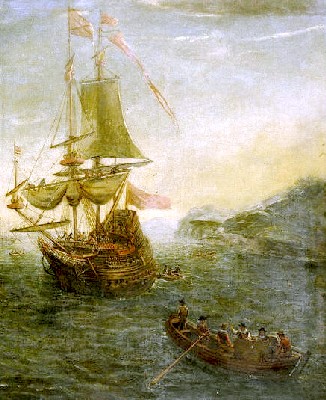
Artist: Gaspar van Eyck - Port Scene (17th century)
Her name?... Did you get off your boat, or did you receive from them [other boats encountered], cloth, papers, people, animals, or anything else? How many people left [the last port]? How many [people] are you bringing, in the service of the vessel, passengers, or garrison if you go to war?"8 They also asked if anyone had any swellings (buboes - a possible indication of bubonic plague) on the ship.
Note that the questions asked according to all these period documents closely resemble those which Howard reported sailors were asked almost a century later.
A couple accounts mention the care observed in keeping the people who processed and questioned the incoming sailors at a distance from before the ship's status was determined. Howard explains that at Marseille, France, the Health Office (Le Bureau de Sante) had an outer room, where ship captains were taken to report. "At two feet distance there is an iron lattice with a door, which is opened only by the servants of the intendants, or directors, who are here in waiting"9. At Livorno, navy sailor Samuel Atkins reported in February of 1681 that "wee were suffered to speak with ye merchants at a distance, who told us wee were not to expect prattick they being very scrupulous to give it any coming from ye westward, the plague being at Cadiz."10
1 John Howard, An Account of the Principal Lazarettos In Europe, 1791, p. 18; 2 Howard, p. 17-8; 3 Howard, p. 19; 4 Instruzzioni e gouerno del lazzaretto di Messina per la scala franca, 1695, p.6 - translated by the author; 5 Instruzzioni e gouerno del lazzaretto di Messina.., 1695, p.7; 6 Howard, p. 19; 7 Simona Olivieri, "Istruzione ed ordini per la Sanità da osservarsi in tutti quei luoghi che hanno giurisdizione al mare, nell'una e l'altra Riviera della Serenissima Repubblica, compreso il Regno di Corsica, ed isola di Caprara", La Berio, Jan-Jul, 1999, p. 24-5; 8 Eduardo Freire de Oliveira & Câmara Municipal de Lisboa, Elementos para a historia do municipio de Lisboa, Tomo X, 1899, p. 425; 9 Howard, p. 3; 10 Samuel Atkins, "A Sailor's Journal", Colburn's United Service Magazine, Part 1, 1854, p. 206

